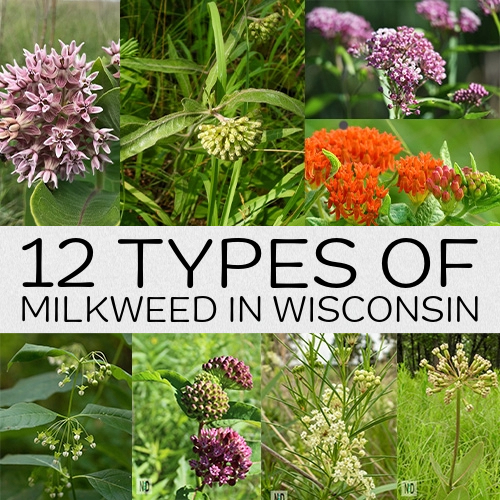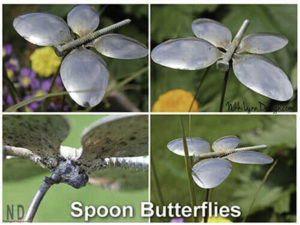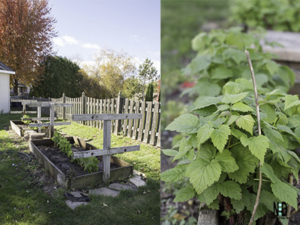I often wander through wild prairies and meadows, marveling at the Milkweed patches that thrive in their untamed splendor. These unassuming plants are more than just lifelines for Monarch butterflies; they’re bustling ecosystems in their own right, supporting a variety of insects and adding a touch of wild beauty to the landscape.
With Monarch populations still in decline, farmers across the Midwest are wisely setting aside prairie spaces, and I’ve found that exploring these natural areas has become a simple yet profound way to connect with nature.
In this post, I’ll share insights on 12 Milkweed species, weaving in interesting facts and the diverse insects they attract. Whether you’re a fellow nature enthusiast or just curious, let’s dive into these plants one by one, drawing from my own experiences of wandering and observing.
12 Milkweed Plants Of The Midwest
1.) Common Milkweed
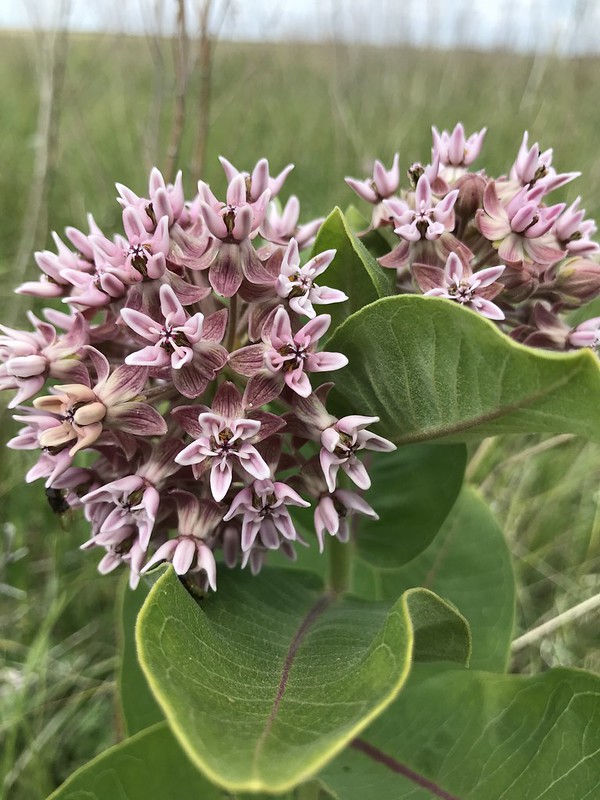
Common Milkweed (Asclepias syriaca) is the quintessential prairie staple, with its tall stems and clusters of fragrant pinkish-purple flowers that wave like old friends in the wind.
I collected common milkweed seed a few years ago and planted them along the edges of my deck last summer.
The plants drew Monarch caterpillars but also served as a magnet for bumblebees and honeybees, who flock to their nectar-rich blooms for a quick energy boost.
It was also where I had the opportunity to witness the lifecycle of the Milkweed Tussock Caterpillar.
This species has been used in traditional practices for its potential soothing properties on the skin, though it’s always wise to handle it carefully—its milky sap can irritate sensitive skin.
Beyond Monarchs, you’ll often spot milkweed bugs and aphids feasting on the seeds and leaves, creating a mini food web that reminds me of nature’s intricate balance.
| Common Name: | Common Milkweed |
|---|---|
| Scientific Name: | Asclepias syriaca |
| Sun: | Full Sun |
| Soil: | Grows well in any type of soil |
| Height: | 4 -6 feet |
| Bloom Time: | June – August |
| Zone: | 3-9 |
2.) Butterfly Milkweed
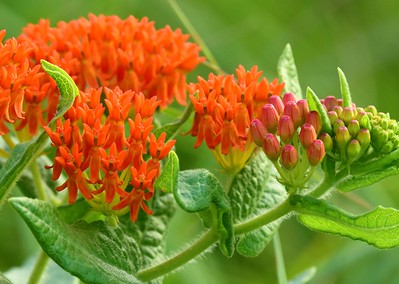
Butterfly Milkweed (Asclepias tuberosa) stands out with its vibrant orange flowers that light up sunny spots like bursts of sunshine, making it a favorite for drought-prone areas.
I’ve watched it transform a dry corner in a roadside garden into a lively hub, not just for Monarchs but also for various butterflies like fritillaries and swallowtails, who sip its nectar during their migrations.
Unlike some Milkweeds, this one has a non-toxic sap, which Native American tribes historically used in dyes and remedies—always remembering that these are cultural uses, not medical advice.
Other insects, such as native bees and wasps, rely on it for pollen, and I’ve even seen ladybugs using the plant as a hunting ground for aphids, turning the patch into a natural pest control zone.
| Common Name: | Butterfly Milkweed |
|---|---|
| Scientific Name: | A. tuberosa |
| Sun: | Full Sun |
| Soil: | Well-drained soil |
| Height: | 2 – 3 feet |
| Bloom Time: | June – August |
| Zones: | 3-9 |
3.) Clasping Leaf Milkweed
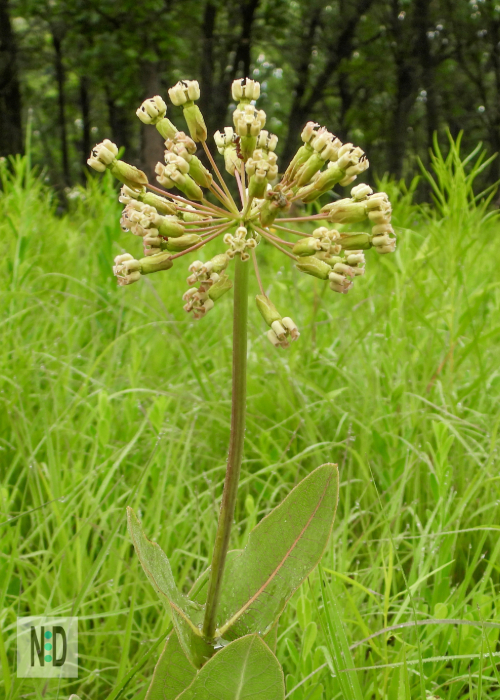
Clasping Leaf Milkweed blooms in most Eastern U.S. states in areas like open fields, roadsides, and open woodland areas with full sunlight.
Clasping Leaf Milkweed (Asclepias amplexicaulis) is a bit more understated, with its clasping leaves and subtle pink to purplish blooms that hug the stem like a gentle embrace, perfect for blending into woodland edges or less formal gardens.
Its a haven for not only Monarch caterpillars but also small beetles and flies that help with pollination.
This species is adapted to sandy soils and can tolerate poor conditions, making it a resilient choice for restoration projects—I’ve read it’s one of the first to pop up in recovering prairies. Besides Monarchs, ants are frequent visitors, often farming aphids on their stems, which adds a fascinating layer of insect interactions to observe.
| Common Name: | Clasping Leaf Milkweed |
|---|---|
| Scientific Name: | A. amplexicaulis |
| Sun: | Full Sun |
| Soil: | Loves sandy soil |
| Height: | 3 – 4 feet |
| Bloom Time: | May – August |
4.) Poke Milkweed
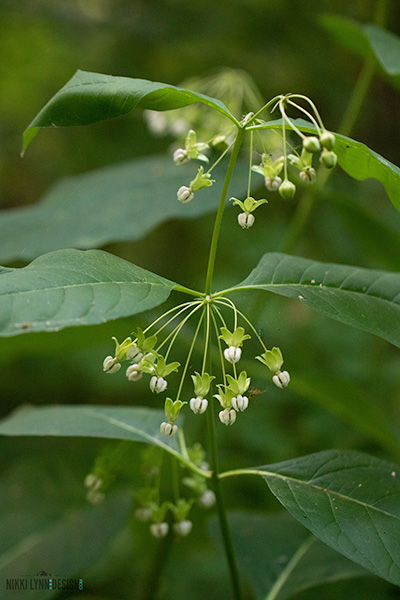
Poke Milkweed (Asclepias exaltata) brings a touch of elegance with its tall, airy stems and white to greenish flowers that sway in the breeze, thriving in partial shade and moist soils—ideal for the dappled light of forests.
From what I have witnessed, planting it near a tree line creates a serene spot where I’ve spotted not just Monarchs but also moths like the milkweed tussock moth, which uses the leaves as a food source for its larvae.
I love how the flowers parachute off the plant.
| Common Name: | Poke Milkweed |
|---|---|
| Scientific Name: | Asclepias exaltata |
| Sun: | Part to Full Sun |
| Soil: | Rich soil |
| Height: | 2 – 6 feet |
| Bloom Time: | July – August |
5.) Tall Green Milkweed
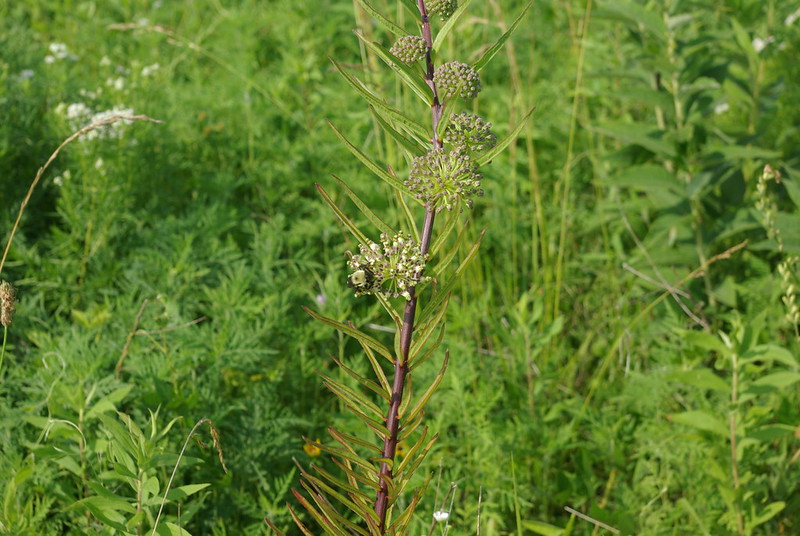
Tall Green Milkweed (Asclepias hirtella) lives up to its name with its slender, upright growth and greenish-white flowers that reach impressive heights, making it a standout in open fields or along fence lines.
It proves hardy against the elements, supporting not only Monarchs but also a variety of flies and beetles that aid in cross-pollination.
A cool fact: This species is particularly drought-resistant and can form extensive colonies. Beyond Monarchs, it’s a favorite for long-tongued bees and even some spiders that weave webs among its stems, turning it into a mini ecosystem.
| Common Name: | Tall Green Milkweed |
|---|---|
| Scientific Name: | A. hirtella |
| Sun: | Full Sun |
| Soil: | Well Drained Soil |
| Height: | 2 -4 feet tall |
| Bloom Time: | June – August |
6.) Green Flowered Milkweed
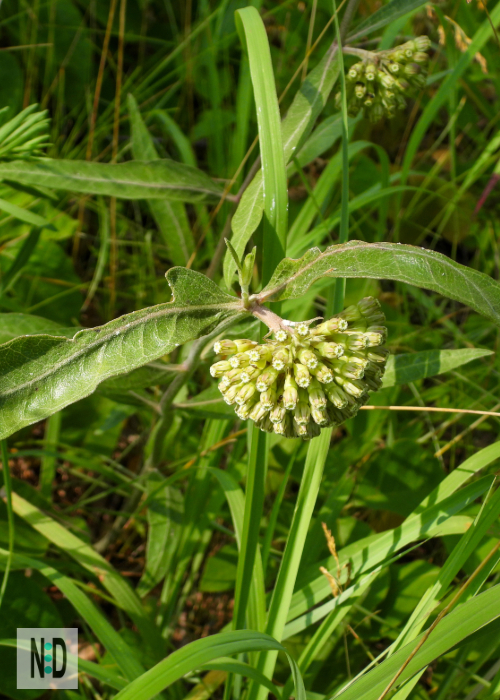
Green Flowered Milkweed (Asclepias viridiflora) offers a more subdued charm with its unassuming green blooms that blend seamlessly into natural landscapes, perfect for native plant enthusiasts in Wisconsin.
It attracts Monarch caterpillars but also small sweat bees and wasps seeking its discreet nectar sources.
Other insects, like leaf beetles, often munch on its foliage, and I’ve found that observing these interactions has taught me about the plant’s role in supporting overlooked garden dwellers.
| Common Name: | Green Flowered Milkweed |
|---|---|
| Scientific Name: | A. viridiflora |
| Sun: | Full Sun |
| Soil: | Dry soil |
| Height: | 12 – 32 inches |
| Bloom Time: | July |
7.) Prairie Milkweed
Prairie Milkweed (Asclepias sullivantii) is a robust choice for sunny, open spaces, with its deep pink flowers that evoke the vast Midwestern prairies. The plant is on the Wisconsin threatened plant, and mainly found between Milwaukee and Madison.
It draws in Monarchs while also hosting milkweed longhorn beetles and various moths that lay eggs on its leaves. Besides Monarchs, bumblebees are regular visitors, and I’ve enjoyed the way it fosters a community of pollinators that spill over to nearby plants.

| Common Name: | Prairie Milkweed |
|---|---|
| Scientific Name: | A. sullivantii |
| Sun: | Full Sun |
| Soil: | Well Drained |
| Height: | 2 – 4 feet tall |
| Bloom Time: | June – August |
8.) Oval Leaf Milkweed
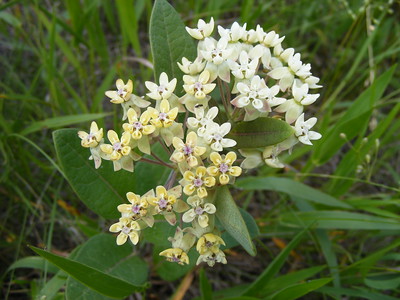
Oval Leaf Milkweed (Asclepias ovalifolia) features distinctive oval leaves and pale pink flowers, making it well-suited for sandy or rocky soils in drier regions.
It attracts ants and small flies that help with pollination. Other insects, like aphids and their predators, create a balanced dynamic on its stems, which I’ve come to appreciate as a lesson in natural harmony.
| Common Name: | Oval Leaf Milkweed (Dwarf) |
|---|---|
| Scientific Name: | A. ovalifolia |
| Sun: | Part to Full Sun |
| Soil: | Sandy |
| Height: | 10 to 24 inches |
| Bloom Time: | June – August |
9.) Woolly Milkweed
Woolly milkweed is a threatened native milkweed plant in the state of Wisconsin and can be found in dry rocky hillsides. Woolly Milkweed (Asclepias lanuginosa) gets its name from its fuzzy, wool-like stems and leaves, topped with soft pink flowers that give it a cozy, textured appeal for wetland-adjacent gardens.
I have heard, it’s a magnet for Monarchs and also for native bees and butterflies like the pearl crescent, which use it as a nectar stop. Beyond Monarchs, you’ll find milkweed bugs and even some predatory insects that keep pests in check, adding to the plant’s ecological value.
If you find one in Wisconsin, let me know. I would like to see a plant.

| Common Name: | Woolly Milkweed |
|---|---|
| Scientific Name: | A. lanuginosa |
| Sun: | Full Sun |
| Soil: | Dry Well Drained |
| Height: | 10-12 inches |
| Bloom Time: | June – July |
10.) Whorled Milkweed
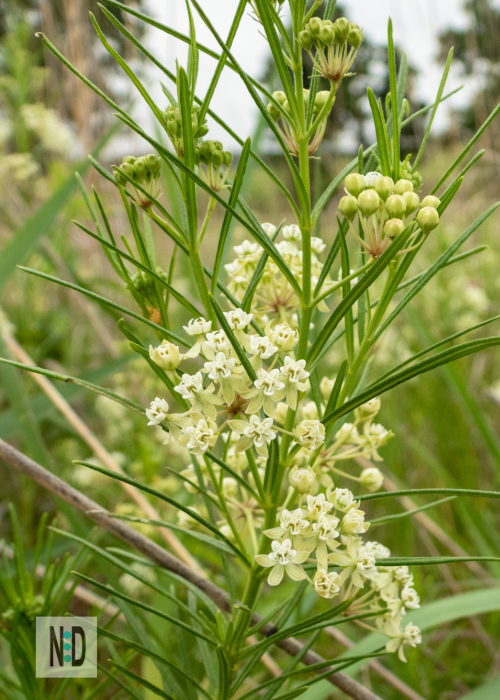
Whorled Milkweed (Asclepias verticillata) stands out with its whorled leaves and tiny white flowers, thriving in dry, sunny spots and bringing a delicate structure to the garden.
The plant supports Monarchs alongside small bees and flies that appreciate its fine blooms. Other visitors to this milkweed include aphids and their natural enemies, like lacewings, creating a fascinating insect drama.
It is highly toxic, which deters herbivores but makes it a safe haven for certain insects.
| Common Name: | Whorled Milkweed |
|---|---|
| Scientific Name: | A. verticillata |
| Sun: | Full Sun |
| Soil: | Fine soil |
| Height: | 1-3 feet tall |
| Bloom Time: | May – September |
11.) Purple Milkweed
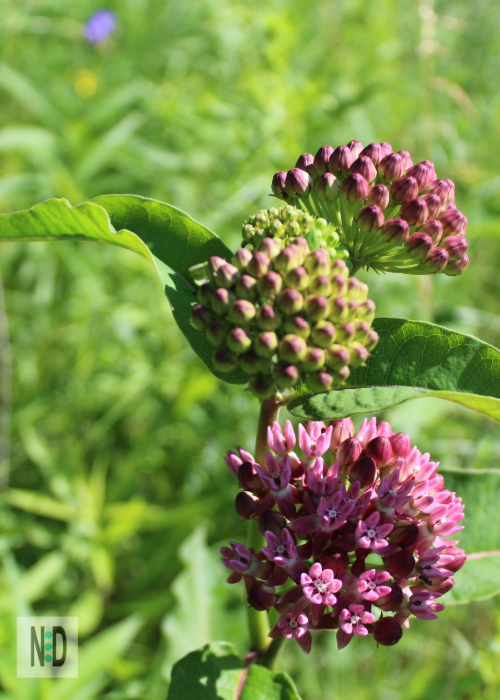
Purple Milkweed (Asclepias purpurascens) dazzles with its rich purple flowers that bloom early in the season, offering a pop of color for Wisconsin’s transitional landscapes.
It draws Monarchs and also bumblebees, which are key pollinators due to their strength in accessing the deep flowers. .
Besides Monarchs, moths and beetles often visit, enhancing its role as a biodiversity booster.
| Common Name: | Purple Milkweed |
|---|---|
| Scientific Name: | A. purpurescens |
| Sun: | Particle to Full Sun |
| Soil: | Drained |
| Height: | 2-3 feet tall |
| Bloom Time: | June-July |
12.) Swamp Milkweed
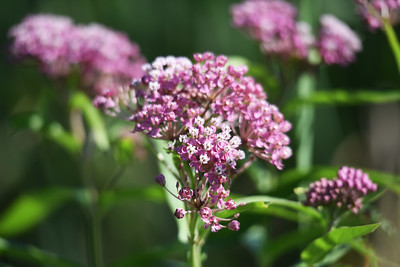
Swamp Milkweed (Asclepias incarnata) is a moisture-lover with clusters of pink flowers that thrive in wetter areas, turning boggy spots into vibrant displays. It attracts Monarchs along with dragonflies and various bees that skim its surfaces.
Other insects, like damselflies and hoverflies, use it as a perch and food source, making it a cornerstone for wetland ecosystems.
The plant breaks through the soil in spring, but you will not see flowers until summer.
| Common Name: | Swamp Milkweed |
|---|---|
| Scientific Name: | Asclepias Incarnata |
| Sun: | Full Sun |
| Soil: | Very moist to Wet |
| Height: | Almost 60 inches tall |
| Bloom Time: | June – August |
| Bloom Color: | Beautiful pink and purple flowers |
Besides purchasing, seed, you can collect a milkweed seed pod from milkweed plants in the wild to plant in your own gardens. Milkweed is vital to the monarch butterfly lifecycle. Butterflies like black swallowtails, silver-spotted skippers, milkweed tussock caterpillars, and milkweed bugs. also, use the plant for a food source.
Additional Posts
9 Woodpeckers of Wisconsin
Wildflowers and Invasives of Wisconsin
Flowers That Attract Hummingbirds
Wildflowers That Attract Birds
AFFILIATE POLICY: Posts on this site may contain links to outside vendors that pay me a commission when you purchase from them, at no additional cost to you. Thank you for supporting this site!
Practical Tips and a Gentle Reminder
Working with Milkweed is rewarding but requires care—always wear gloves when handling to avoid skin irritation from the sap, and keep it away from pets and children due to its toxicity. For planting or observing, aim for spring or early summer in Wisconsin, matching each species to your local soil and light conditions. Start by exploring nearby wild areas, and if inspired, consider adding some to your space to support these ecosystems.
As I reflect on these Milkweed wonders in the wild, I’m reminded of how every plant tells a story of connection and resilience. Have you explored these species in your local areas, or do you have a favorite insect sighting to share? Leave a comment below—I’d love to hear your experiences and tips. If this inspires you, take a walk in nature or grab some seeds to plant; it’s a small step toward a bigger impact.
AFFILIATE POLICY: Posts on this site may contain links to outside vendors that pay me a commission when you purchase from them, at no additional cost to you. Thank you for supporting this site!
